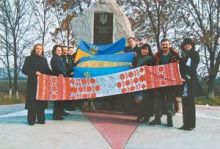Interestingly, The Day carried a series of publications about Mykola Khriienko’s project “Ukrainians beyond the Urals” simultaneously with the Russian authorities attack on Ukrainian organizations in Russia. This makes the immense project, created by a single man, all the more important. It is not without a reason that The Day picked Khriienko as Person of the Year 2010. Unlike Ukrainian diplomats and politicians, Mykola is aware of how important it is for Ukrainians living in Russia to have contacts with their European fatherland.
Khriienko describes the third and final stage of his project as the most problematic. It began with funding problems (2009 was the middle of the economic crisis). The route of this stage should have covered Russia’s northern part from its easternmost settlement, the village Uelen, to European Murmansk. But fate decided otherwise. Khriienko set out from Uelen on April 26, 2009, according to the schedule, and already on July 8 in Bilibino, Chukotka, his plans were crossed by problems with obtaining permission to work as a journalist and the excessive attention of Russia’s Security Service.
After a long period of petitioning in Moscow and Kyiv, the journalist returned to the route on March 26, 2010. “I’m glad it happened so,” Khriienko, who is faithful to his philosophy to see some good in everything, told The Day, “owing to this I met wonderful people who helped me in all possible ways. For example, the head of Russia’s Union of Journalists Vsevolod Bogdanov, who wrote a cover letter for me. Be it not for the obstacles I would not have taken up a new aspect of my research – capturing the liquidators of the aftermath of the Chornobyl disaster, who are now residing in Russia.”
In spite of all the twists and turns, the third stage of the project “Ukrainians beyond the Urals,” which took place mostly between the Polar Circle and the coast of the Arctic Ocean was of great importance. Major destinations included Norilsk, the Solovetsky Islands, Sandarmokh. Like in the two previous parts of the project, Khriienko left embroidered towels, rushnyks, blue-and-yellow banners and earth from Ukraine’s geographical center in all the places where he stopped.
“One of my greatest impressions was shooting in the Yur-Shor Memorial,” the researcher explained. This memorial is dedicated to those who perished in Vorkuta’s camps, and the prisoners of the mine No. 29, Yur-Shor, executed on August 1, 1953, “The upper layer of the ground thawed out, and I fell into the ground knee-deep between the graves. That was a dreadful feeling.” No less impressive was the visit to the memorial cemetery at the foot of Schmidt Mt. in Norilsk, where it was impossible to stay more than two hours in the open, with a temperature of 30 degrees bellow zero and strong winds. In labor camps the prisoners had to do hard physical work for 12 hours a day in such conditions.
In the Solovetsky Islands Khriienko first went to the prison cell No. 15. This place is known to historians because the last Kish otaman of the Zaporishian Sich Petro Kalnyshevsky served a prison sentence for 22 consecutive years. Not only did Khriienko visit this legendary cell, he asked the museum keepers to leave him alone in the otaman’s quarters. The cell is half-covered with earth, with a small slot instead of a window. “I came up to this window and leaned with my arms against it. I could only see a piece of the cemetery. And that’s all. I think when the snow fell, it got completely dark in the cell. I tried to understand what the strong-willed Cossack from the steppe felt when he looked through this slot and what he thought about in those 22 years. It was a strange feeling.”
One more fantastic event of the third stage is the night Mykola Khriienko spent in the forest massif of Sandarmokh, where over 9,500 people of 58 nationalities were executed and lie buried. Representatives of the Ukrainian intelligentsia also perished there. “In the forest portraits of the dead prisoners are pinned to trees. When you stand there, you have a feeling that the portraits look at you with the eyes of executed people,” Khriienko told The Day.
“The 20th century was a century of great terror, notably in 1937-38. Sorrow hovered above the country, especially Karelia, where dozens of GULAG camps were located. Sandarmokh became the heart of this sorrow. Ukraine lost many people here. They were deprived of the right to live, personal inviolability, but they received a right for eternal memory” is what the deputy head of the Medvezhyegorsk Raion Museum Elena Grishina wrote in the travel book that Khriienko carried with him in all three stages of his project.
Covering the road of sufferings of thousands of Ukrainians, Khriienko also met people who managed to find happiness far from their homeland. Most of them live with memories of their native land that are frequently idealistic. Given the absence of full-fledged Ukrainian cultural centers and tours to the places of residence of the Ukrainian diaspora, these recollections remain by far their only connection with Ukraine. “Take care of Ukraine, my dear fellow countrymen!” Natalia Lytvynenko-Orlova from Murmansk wrote in Khriienko’s travel book.










